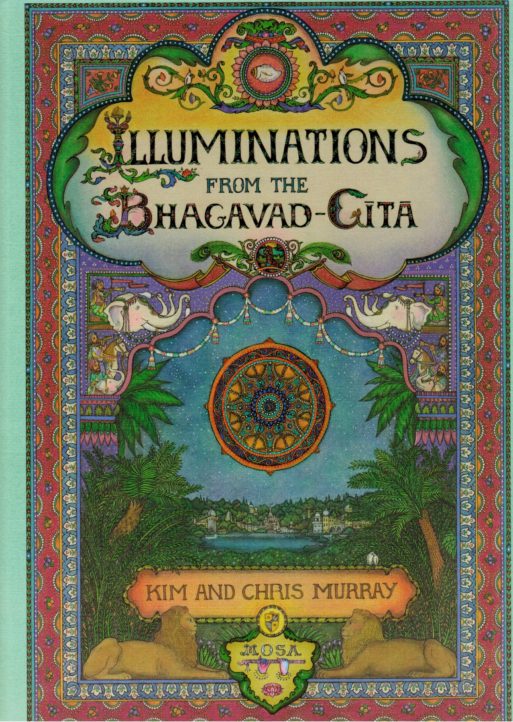 Like a moth to a flickering flame, I was drawn to this tiny hand-cupped sized book of gold embellishment: Illuminations From The Bhagavad-Gita. I confess it was a combination of factors that drew me in. The 40-colored pages (plates by authors & artists Kim & Chris Murray) grabbed my eye and the mysticism of Bhagavad-Gita intrigued me, but when I cracked it, it was a saying about life that prompted me to purchase it. The saying was:
Like a moth to a flickering flame, I was drawn to this tiny hand-cupped sized book of gold embellishment: Illuminations From The Bhagavad-Gita. I confess it was a combination of factors that drew me in. The 40-colored pages (plates by authors & artists Kim & Chris Murray) grabbed my eye and the mysticism of Bhagavad-Gita intrigued me, but when I cracked it, it was a saying about life that prompted me to purchase it. The saying was:
“For the soul there is never birth nor death nor, having once been, does he ever cease to be, he is unborn, eternal, ever-existing, undying and primeval. He is not slain when the body is not slain.”
Even for those who do not believe in a soul, the idea of someone you love having an essence (soul) that existed and will continue on is actually truthful. That person begins with their mother’s desire to bring a child into the world and lives on in the memories and hearts of those who held them beloved. This is a book for the spiritual, but is not off-putting to those who may not be. I also loved its promise of “Illuminations” through knowledge, art or enlightenment – verses made beautiful from all dimensions.
“Even if you are considered to be the most sinful of all sinners, when you are situated in the boat of Transcendental knowledge, you will be able to cross over The ocean of miseries.”
Bhagavad-Gita was new to me. The illustrations opulently introduced me to a sampling of the “Gita” by also presenting a fresh view of this popular classic 700-verse Hindu spiritual scripture, that is part of Mahabharata. Mahabharata is acknowledged as “the longest poem ever written” and thankfully the authors distilled it down to a limited selection of the literature. It’s a good one for those wrangling with regrets or about to leave earth while struggling with questions of a soul and their legacy.
“Never was there a time when I did not exist, nor you, nor all these kings; nor in the future shall any of us cease to be.”
This book is more lavish illustrations than verses to transform one’s state of mind in preparation for the wisdom of the words. “It is not a sectarian doctrine, meant for a particular faith or class of people.” Kim and Chris Murray choose to embrace everyone. The “Gita,” as it is also referred to, is an ancient story reflecting the timelessness of life’s moral and ethical conflicts. The story has princes, princesses, battles and goals within a life to ponder, but the book intentionally only gives a brief overview. There is also much confusion around what date it was written, but this is of no consequence to its modern day relevancy. “Today, we are likewise burdened with many serious problems. War, poverty, pollution and greed are everywhere, and getting worse. This is an age of anxiety.” The authors cherry-picked some of the “lucid” verses to both formally yet casually introduce the transcendental mystery of wisdom to those in our current day who may pick it up while standing at a cash register in a store.
“For one who is situated in transcendental consciousness, the miseries of material life exist no longer in such a happy state, one’s intelligence is steady.
One who is not in transcendental consciousness can have neither a controlled mind nor steady intelligence, without which there is no possibility of peace. And how can there be any happiness without peace?”
It worked since I have now dabbled in the allegory of the Mahabharata. Otherwise I would have most likely never encountered it.

 “Illuminations From The Bhagavad-Gita” by Kim and Chris Murray
“Illuminations From The Bhagavad-Gita” by Kim and Chris Murray



 How Dare You Die Now!
How Dare You Die Now!
 Debating Medical Aid in Dying
Debating Medical Aid in Dying
 “Help Me, Helen”
“Help Me, Helen”














